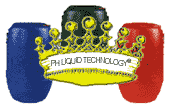
Walther Van Kerrebroeck Technology and strategy for PH Liquid Buffersystems and bufferfilms. |
|
A specialist in functional ingredients, international meat industry supplier PH Liquid Belgium N.V. recently launched an all-out product introduction campaign for its buffer phosphate and buffer film systems, supported with advertisements in trade magazines and a full slate of extra information on the company's Web site. MEAT PROCESSING Global (MPG) took a closer look behind the scenes of what PH Liquid markets under its liquid extract and buffer system brands. Walther Van Kerrebroeck, PH Liquid Belgium's meat-technologist and product manager, described how PH Liquid's buffer systems® and buffer films® work and the benefits meat manufacturers can expect in terms of processing support, health risk control, quality assurance, extension ofshelf life and enhancement in the final product.
PH Liquid Belgium N.V. (PHL) is part of a larger corporate group, which operates with plants in several countries, and ships to meat industry companies worldwide. It views partnership relations with its customers in research and development and related fields of interest as an essential focal point of its business commitment. Currently the company is expanding to solidify its presence in the international marketplace.
MPG: In a nutshell, when referring to your company's overall range of PH liquid buffer systems® and buffer films®, what type of products are we talking about?
PHL: Regard pH liquid as an acid medium which, when combined with such mildly alkaline buffer phosphates as our 60151 and 60152 varieties, works to create a buffering function for the pH range desired. It works to maintain the desired pH level, even when unfavourable circumstances come into play, which would otherwise change it or upset it.
MPG: What's new about the buffer system and its underlying concept?
PHL: For a start, our patent applied-for buffer systems® and buffer films® are manufactured in synchronization with the additive formulation governing our pH liquid extract and the buffer phosphates 60151 and 60152 - which, in turn, constitute premixes based on various types of food-grade phosphates.
MPG: How does this translate to benefits on the manufacturing floor?
PHL: First of all, PH Liquid buffer systems® operate to create an optimum, safe processing environment for manufacturing products such as cooked ham, liver sausage, pâtés, cooked or dry sausages and similar products. Also, buffer systems® and films retard bacterial growth and thus help prevent food-borne infections as may be caused by Salmonella, Listeria and various types of E.coli. Next, shelf life is substantially increased, even despite unfavourable storage temperatures. To explain this benefit in more detail: under the influence of a stable pH buffer, heat-treated products' shelf life is that much longer. And this plus factor, in turn, has positive impact on finished products' taste, colour, texture and other sensorial attributes, while also contributing to improved "sliceability" or "spreadability", as the case may be, and to preserving solid colour stability on slices or otherwise cut-exposed product surfaces.
MPG: What sets buffers and films apart from conventional use of phosphates?
PHL: First, liquid extracts and buffer phosphate premixes are specifically interadjusted to produce a buffered pH. This can be seen as a direct result of special blend formulas devised to arrive at the right combination of food-grade phosphates for a given mix preparation.
Secondly, when sprayed onto the exterior surfaces of carcases, primals or cuts of deboned meat, liquid buffer films® delay growth of micro-organisms, keep products from drying-out, help preserve good taste and odour, assist in colour stability and prevent gas formation inside freshpacks.
MPG: What effects do liquid buffer systems® exercise when applied to different meat products? For instance, how do they work with frankfurter-type cooked sausages, where necessary emulsification necessitates water uptake? And—by contrast—how do they work with uncooked sausage varieties, where fermentation takes place and water is given off as a result?
PHL: Apart from the pH buffering function mentioned, buffer phosphates have a powerful water-binding and emulsifying capacity. Resultant benefits include increased yield, product homogeneity, prevention of drip loss and, to repeat, last not least with the benefit of retarded bacterial growth. More specifically, when buffer systems® are applied to franks, cooked hams, cooked-in-bag products, etc., thereby maintaining pH6 as the pH level most appropriate for them, the benefits again include upkeep of taste qualities and prolonged shelf life, because in-pack gas formation is prevented.
As for salamis and other uncooked/fermented sausage, the exact same benefits arise from buffer-locking the pH4.9 min./5.1 max. range which is best for these type of products. Improved sliceability, absence of fat particle colour changing to an unsightly yellow and prevention of rancidity should be seen as additional plus factors, and are made possible by a fine-tuned lineup of food-grade acids in the properly dosed pH liquid extract.
MPG: Dwelling on the extended shelf life benefit for a moment, which appears to be a regularly recurring factor in PH Liquid's product communication efforts, what specific safe keeping periods are attained for specific products?
PHL: Given simultaneous application of liquid buffer systems® and buffer phosphates and a 2 °C/35.6 °F storage temperature, PH Liquid Belgium N.V. guarantees these shelf life periods: Cooked, mould-formed hams (72C/162F core temp.): 2 months min./4 months max; cooked-in-bag products: 12 months min./18 months max.; cooked sausage and/or liver sausage in artificial casings (72C/162F heat treatment): 6 months min./9 months max.; pâté preparations, vacuum-packaged (80C/176F heat-treatment): 2 months min./4 months max.
MPG: What addition levels are recommended for use with meat products?
PHL: Adding liquid extract and the respective buffer phosphates at the .5 per cent level, relative to the finished meat product, is all that's required. Also remember that no extra measures must be taken or changes in production processes implemented to ensure these benefits occur. This, when viewed in context with low dosage levels, amounts to a value-for-money or cost-saving benefit as well.
MPG: Are there any particular points a user of pH buffer products must remember when labelling finished products pursuant to EU label declaration rules?
PHL: Buffer phosphates are declared as such, giving their respective number designations; food-grade phosphates are listed on product labels under their respective E-numbers in the 'E-451' series.
MPG: In your advertisement messages, the "pH Liquid Extract Buffer System" is described as "the world's best and safest" for use with diverse meat products. How should "safe" be interpreted in this particular respect?
PHL: In terms of retarded bacterial growth as an essential step in preventing diseases caused by food-borne pathogens, and in terms of products' guaranteed secure shelf life"even under less-than-favourable storage conditions caused by fluctuating temperatures. Maximum product and consumer safety, that is.
More in-depth information can be obtained by visiting the company's multilingual Web site at www.ph-liquid.com
Walther Van Kerrebroeck: technology and strategy for PH Liquid Buffersystems and bufferfilms together with Bufferphosphate 60150 / 60151 / 60152.
Meat Processing Global and Procesamiento de Carne: edition November / December 2000.
 "Interview
with Meat Processing Global and PH Liquid Organization, published
in Meat Magazine, november-december 2000 and Procesamiento de Carne
november-december 2000 and China Feed, Grain & Oilseed november-december
2000. Total circulation : 38.600 ex. distributed over 142 countries."
"Interview
with Meat Processing Global and PH Liquid Organization, published
in Meat Magazine, november-december 2000 and Procesamiento de Carne
november-december 2000 and China Feed, Grain & Oilseed november-december
2000. Total circulation : 38.600 ex. distributed over 142 countries."